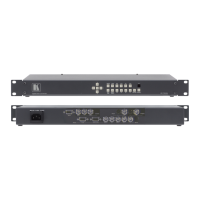28
Zoom and Shrink functions to be adjusted independently, thus allowing custom
aspect ratios to be created, or to convert from one aspect ratio to another. When
left as “Simple”, the H/V components of Zoom and Shrink are adjusted equally i.e.
H is equal to V.
The Flicker Reduction menu item will only appear if you have selected a low
resolution interlaced output such as PAL or NTSC. If you are using CV or YC
outputs, this adjustment may be of interest, particularly when you have line
drawings or similar fine detail. You can choose from four possible Flicker Reduction
settings. You should use as little Flicker Reduction as possible because the Vertical
detail will be softened at the highest setting.
Flicker mode Function
Off Disables flicker reduction (sharpest mode).
Low Suitable for most input sources.
Med. Enough for most situations such as thin line drawings
High Highest amount of flicker reduction. Will cause loss of
vertical detail in some images.
Image smoothing reduces the jagged-edges sometimes seen within an output
image by softening it. It typically improves the quality of a scaled image greatly.
There are four possible settings for this adjustment: “Off”, “Med.”, “High”, and
“Auto”. The “Auto” setting is generally thought to be most desirable and will vary the
smoothing process according to the amount of zoom taking palce.
Occasionally, it’s necessary to cause the output image to be flipped Vertically,
Horizontally or both – most commonly when a video projector is ceiling mounted, or
for special effects.
De-glitch is used to provide clean, seamless switching between video sources,
since it is unusual for all the inputs to be synchronized with one another. The De-
glitch function ensures that the switches between these inputs do not cause the
Adjust windows
Image smoothing [Auto]
Adjust windows
Image flip [Off]
Adjust windows
De-glitch [ On]
Adjust windows
Flicker Reduction [Low]

